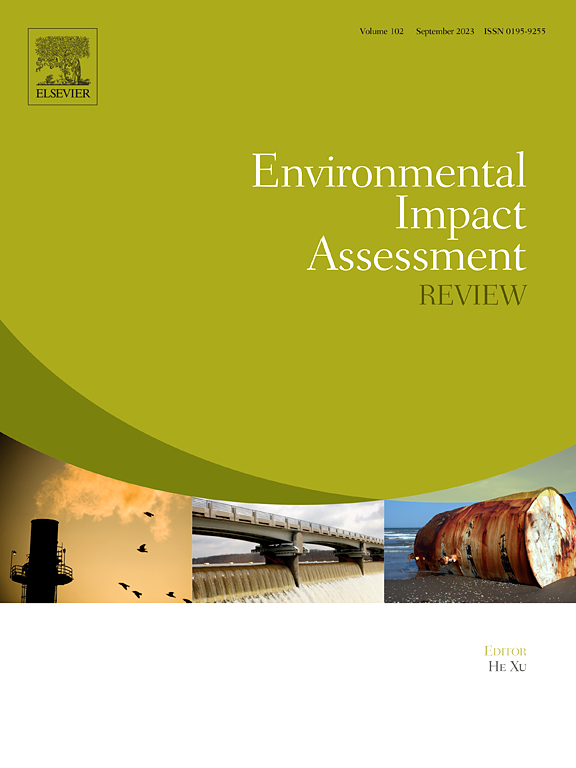基于多属性决策方法的中国生态补偿资金分配新框架
IF 11.2
1区 社会学
Q1 ENVIRONMENTAL STUDIES
引用次数: 0
摘要
公平合理的补偿资金分配是有效实施生态补偿政策的关键。然而,由于现有研究忽视了社会稳定、技术创新和民生发展,没有考虑到时间、认知差异以及利益相关者在最终决策中主观判断的模糊性,导致欧盟政策难以实现预期目标。本文构建了以生态状况、环境治理、经济发展、社会公平、技术水平和民生安全为核心的经济共同体资金分配多维指标体系。并将时间维度和专家意见维度纳入指标权重的计算中。通过引入三角模糊数,提出了一种新的多属性决策框架——“主客观综合权值+决策模型”,以确定具有较高可接受度的ECFA方案。结果表明:(1)综合考虑社会、技术和民生因素的ECFA指标体系在区域间的分配结果差异不大,且更容易被地方政府接受。(2)生态状态、环境管理、经济发展、社会公平、技术水平和生计安全的权重分别为0.28、0.17、0.14、0.15、0.13和0.13,人均水资源对ECFA的影响最大,年降雨量对ECFA的影响最小。③2022年中国ECFA标准呈现西部高东部低的格局;西藏获得的资金额度最高(112.8亿元),而江苏获得的资金额度最低(不到3亿元)。(4)与中央政府实际发放的EC资金相比,根据本文提出的决策模型,16个地区获得了更高的配额。西藏的差额最大,达75.9亿元。本文为各国优化ECFA方案设计、完善ECFA机制提供了参考。本文章由计算机程序翻译,如有差异,请以英文原文为准。
A new framework for eco-compensation funds allocation in China based on multi-attribute decision-making method
A fair and reasonable allocation of compensation funds is key to effectively implementing the eco-compensation (EC) policy. However, as existing studies ignored social stability, technological innovation, and livelihood development, and failed to consider time, cognitive differences, and ambiguities in the subjective judgments of stakeholders on the final decision-making, EC policies had difficulties in achieving the desired goals. This paper constructs an EC funds allocation (ECFA) multi-dimensional index system integrating ecological state, environmental governance, economic development, social equity, technological level, and livelihood security. Furthermore, it incorporates the dimensions of time and expert opinion into the calculation of indicator weights. By introducing the Triangular Fuzzy Number, a new multi-attribute decision-making framework, the “subjective-objective integrated weights + decision-making model”, is proposed to determine an ECFA scheme with high acceptability. The results show that: (1) The proposed ECFA index system, which takes into account society, technology, and people's livelihood, has allocation results among regions that are not too disparate and more acceptable to local governments. (2) The weights of ecological state, environmental management, economic development, social equity, technology level, and livelihood security are 0.28, 0.17, 0.14, 0.15, 0.13, and 0.13, respectively, with the water resource per capita having the greatest impact on ECFA, and the annual rainfall impacts the smallest. (3) ECFA standards for China in 2022 were high in the west and low in the east; Tibet received the highest fund quota (11.28 billion CNY), while Jiangsu was allocated the lowest quota (less than 0.03 billion CNY). (4) Compared to the actual EC funds issued by the central government, based on the decision-making model proposed in this study, 16 regions obtain higher quotas. Tibet has the largest difference between the two allocations (up to 7.59 billion CNY). This paper provides a reference for countries to optimize the design of the ECFA scheme and improve the EC mechanism.
求助全文
通过发布文献求助,成功后即可免费获取论文全文。
去求助
来源期刊

Environmental Impact Assessment Review
ENVIRONMENTAL STUDIES-
CiteScore
12.60
自引率
10.10%
发文量
200
审稿时长
33 days
期刊介绍:
Environmental Impact Assessment Review is an interdisciplinary journal that serves a global audience of practitioners, policymakers, and academics involved in assessing the environmental impact of policies, projects, processes, and products. The journal focuses on innovative theory and practice in environmental impact assessment (EIA). Papers are expected to present innovative ideas, be topical, and coherent. The journal emphasizes concepts, methods, techniques, approaches, and systems related to EIA theory and practice.
 求助内容:
求助内容: 应助结果提醒方式:
应助结果提醒方式:


